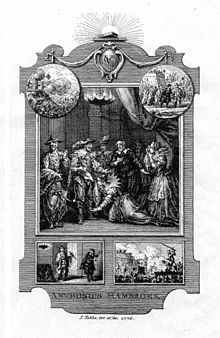Schinderhannes bartelsi
Schinderhannes bartelsi| Schinderhannes bartelsi 시간 범위:이른 데본기 408–400 엄마 PreꞒ Ꞓ OSDCPTJKPg N. | |
|---|---|
 | |
| Schinderhannes의 holotype.크레딧:Steinmann Institute/University 본의 | |
| 과학적 분류 | |
| 킹덤: | 애니멀리아 |
| 망울: | 절지 동물문 |
| 클래스: | †Dinocaridida |
| 순서: | †Radiodonta |
| 패밀리: | †허디과 |
| 지누스: | †Schinderhannes |
| 종: | †S. bartelsi |
| 이항식 이름 | |
| †Schinderhannes bartelsi Kühl, 브릭스 &, 녹, 2009년. | |
hurdiidradiodont(anomalocaridid)의 Schinderhannes bartelsi 종 하나의 표본 하단 Devonian Hunsrück Slates에서 알려져 있다.때문에 이전에, radiodonts만 예외적으로 잘 보존된 화석 침대는 캄브리아기, 100억년 전(Lagerstätten)에서 알려진 그것의 발견 누구나 다 놀랐다.[1]
디스커버리
단 하나의 시편은 Eschenbach-Bocksberg 채석장 Bundenbach에서, 무법자 Schinderhannes 그 지역에서 따왔습니다 발견되었다.그것의 특정한 별명 bartelsi 크리스토프 Bartels, Hunsrück 슬레이트는 전문가 서작·서훈..이 표본은 현재 자연사 박물관, 마인츠에 소장되어 있다.[1]
형태학
Schinderhannes는 약 10센티미터 전신 length[1](6.8cm 오래 telson[4]을 제외하고)에(3.9에).다른 radiodonts처럼, 머리는 가시가 있는 정면의 부속 기관의 쌍,radially-arranged 배mouthpart(구강 콘), 그리고 큰 측면 화합물 한쌍의 눈을 품고 있다.[1]전면 부속 기관과 구두 콘에 대한 상세한 형태학이 한정된 보존 때문에, 그러나 전(예를 들어 거의 같은blade-like endites)전형적인hurdiid 기능을 대표하는 모호하고 있다.[5][3]눈은 다른 hurdiids는 것의 대조가 상대적으로 전방 위치에 있었다.[3]엔 창조 구조체의 흔적 원래 다른 radiodonts에 보기보다는(측면 sclerites)P-elements를 나타낸다 정면의 부속 기관과 샤프트 지역으로 여겨진다.[3]머리와 트렁크('neck의)의 경계를 길고ventrally-protruded 작은 날개의 한쌍과 방대했다.[1]12신체 부분을 부드러운 등 cuticle[2](원래 단단하tergites[1]생각)에 표시된 줄기는 compose.최초 10부문 줄무늬 구조는 원래(예를 들어 Lyrarapax)이 다소(radiodont의 등gill-like 구조)및 뚜껑 근육을 강 모의 칼날을 대표할 수도 있다고 합니다 다른 radiodonts에서 두 가닥 난(분지)flaps,[1]했지만 이후에는 배 조사한 것으로 해석했던의 쌍을 소유하고 있다.[2]제11구간은 더 짧은가, 둥근 작은 날개의 한켤레 갖고 있다.[1]마지막 부분은 부록이 부족했고 긴 척추 같은 텔슨으로 끝이 났다.[1]텔슨 바로 앞에 위치한 복측 항문.[4]
생태
소화관의 보존된 내용물은 다른 포식자들의 전형적인 것으로,[6] 이러한 생활 방식은 가시가 돋은 전두부대의 황홀한 성격과 눈의 크기에 의해 지탱된다.[1]슐린더핸스는 수영선수(네크톤)였을지도 모르며 머리에 긴 플랩을 부착한 채 추진력을 발휘했고, 11구간 짧은 플랩을 이용해 방향을 조종했다.[1]이러한 플랩은 측면에 있는 로브를 사용하여 헤엄을 치지만 Schinderhannes에서 볼 수 있는 특수화가 결여된 캄브리아 라디오돈트의 측면 플랩에서 유래한 것으로 추정된다.[1]
의미
데본기 라디오돈트로서, Schinderhannes의 발견은 그것이 야기시킨 라디오돈트의 거대한 범위 확장 때문에 가장 중요한 것이었다: 이 그룹은 단지 1억년 전, 중하 캄브리아의 라게르스테텐으로부터만 이전에 알려져 있었다.이것은 Hunsrück Slate와 같은 Lagerstetten의 유용성을 강조한다: 이 예외적으로 보존된 화석 지평선은 비-미네랄화 형태를 관찰할 수 있는 유일한 기회일 수 있다.[7]
쉬데르한네스의 발견은 또한 기저 절지동물의 분류에 대한 새로운 가설을 불러일으켰다.한 분류 체계에는 유아스로포드와 유사한 것으로 해석된 문자(예: 테르기이트, 비라무스 부속서)에 기초하여 샤인더한네스의 누이가 다른 라디오돈트 대신 유아스로포드(크라운 또는 '진정한' 절지동물)에 있다.이는 유아사슴도치 혈통이 라디오돈트의 파라피알레틱 등급에서 진화했다는 것을 의미하며, '위대한/전면적인 부속'을 가진 기저 절지동물의 집단이 자연적인 집단이 아니라는 것을 의미하며, 이때 절지동물의 발암성 맹장은 라디오돈트 측면 플랩과 아가미 융합을 통해 생겨났을 수도 있다.[1]그러나, 이 시나리오는 후기 조사의 도전을 받았었는데, 그 이유는 투입성 유두구체 같은 특징들이 오히려 래디오돈트 같은 문자(예: 부드러운 몸통 큐티클, 세타날, 쌍체 플랩 근육)로 의심되었기 때문이다.[2]라디오돈타에 초점을 맞춘 계통학적 분석 또한 샤인더한네스를 라디오돈트 계열 허디아과 내에 반복적으로 배치했다.[8][9][10][4][3]
참조
- ^ a b c d e f g h i j k l m Gabriele Kühl; Derek E. G. Briggs & Jes Rust (2009). "A great-appendage arthropod with a radial mouth from the Lower Devonian Hunsrück Slate, Germany". Science. 323 (5915): 771–773. Bibcode:2009Sci...323..771K. doi:10.1126/science.1166586. PMID 19197061.
- ^ a b c d Ortega-Hernández, Javier (2016). "Making sense of 'lower' and 'upper' stem-group Euarthropoda, with comments on the strict use of the name Arthropoda von Siebold, 1848: Upper and lower stem-Euarthropoda". Biological Reviews. 91 (1): 255–273. doi:10.1111/brv.12168.
- ^ a b c d e Moysiuk, J.; Caron, J.-B. (2019-08-14). "A new hurdiid radiodont from the Burgess Shale evinces the exploitation of Cambrian infaunal food sources". Proceedings of the Royal Society B: Biological Sciences. 286 (1908): 20191079. doi:10.1098/rspb.2019.1079. PMC 6710600. PMID 31362637.
- ^ a b c Lerosey-Aubril, Rudy; Pates, Stephen (2018-09-14). "New suspension-feeding radiodont suggests evolution of microplanktivory in Cambrian macronekton". Nature Communications. 9 (1): 3774. doi:10.1038/s41467-018-06229-7. ISSN 2041-1723. PMC 6138677. PMID 30218075.
- ^ Pates, Stephen; Daley, Allison C.; Butterfield, Nicholas J. (2019-06-11). "First report of paired ventral endites in a hurdiid radiodont". Zoological Letters. 5 (1): 18. doi:10.1186/s40851-019-0132-4. ISSN 2056-306X. PMC 6560863. PMID 31210962.
- ^ Nicholas J. Butterfield (2002). "Leanchoilia, and the interpretation of three-dimensional structures in Burgess Shale-type fossils". Paleobiology. 28 (1): 155–171. doi:10.1666/0094-8373(2002)028<0155:LGATIO>2.0.CO;2. JSTOR 3595514.
- ^ Nicholas J. Butterfield (1995). "Secular distribution of Burgess-Shale-type preservation". Lethaia. 28 (1): 1–13. doi:10.1111/j.1502-3931.1995.tb01587.x.
- ^ Vinther, Jakob; Stein, Martin; Longrich, Nicholas R.; Harper, David A. T. (2014). "A suspension-feeding anomalocarid from the Early Cambrian". Nature. 507 (7493): 496–499. doi:10.1038/nature13010. ISSN 1476-4687.
- ^ Cong, Peiyun; Ma, Xiaoya; Hou, Xianguang; Edgecombe, Gregory D.; Strausfeld, Nicholas J. (2014). "Brain structure resolves the segmental affinity of anomalocaridid appendages". Nature. 513 (7519): 538–542. doi:10.1038/nature13486. ISSN 1476-4687.
- ^ Van Roy, Peter; Daley, Allison C.; Briggs, Derek E. G. (2015). "Anomalocaridid trunk limb homology revealed by a giant filter-feeder with paired flaps". Nature. 522 (7554): 77–80. doi:10.1038/nature14256. ISSN 1476-4687.
외부 링크
- 3억 9천만 년 된 화석 속에서 본 발톱의 기원
- 판다의 엄지손가락: 쉰데르한네스 바르텔시
- ScienceBlogs: Schinderhannes bartelsi, PZ Myers가 G. Kühl 외 연구진이 제안한 클래도그램을 보여주면서 Schinderhannes(그러나 Anomalocaris는 아님)를 Euarthropoda 그룹에 배치했다.




